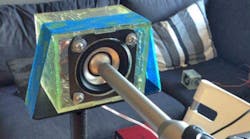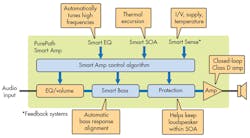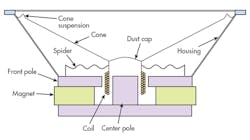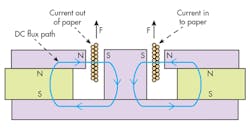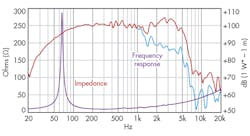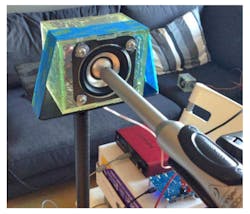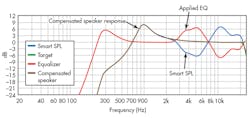How To Get Big Sounds From Small Speakers
One consumer-electronics trend that shows no signs of slowing down is the drive toward ever-smaller devices. Desktop PCs become laptops and then tablets. Portable devices become wearables. And, of course, every succeeding generation is thinner than the last.
In the midst of this rapid change, every smartphone and laptop still depends heavily on an invention that's remained substantially the same for over 90 years: the moving-coil loudspeaker, first patented in 1925. After that initial breakthrough, speaker performance showed only incremental improvement for many years. Sadly, there isn't a Moore's Law for speakers. The same applied to techniques for driving them, at least until recent improvements such as Class-D amplifiers.
In recent years, though, a new generation of "smart amplifiers" is incorporating new driver topologies and digital-signal-processing (DSP) technology. As a result, designers are able to make big improvements in both the quality and volume of sound from speakers, particularly from the very small and cheap units used in many portable devices.
Smart Amplifier Overview
1. The smart amplifier concept includes several digital-signal-processing blocks. (Source: TI)
A smart amplifier can prevent mechanical or thermal failures while simultaneously boosting output and improving audio quality. Unlike a pure analog solution, a smart amplifier incorporates several DSP blocks (Fig. 1). The new blocks include:
Smart EQ: Automatically modifies high frequencies to deliver a flat response or match a target curve.
Smart SOA: Establishes the boundaries of maximum speaker diaphragm excursion and voice-coil temperature during operation based on an electromechanical-thermal model.
Smart Sense: Provides system and system-level sensor inputs such as temperature, speaker voltage and currents, supply voltage, etc.
Protection: Models the current state of the speaker to adaptively change amplifier characteristics to avoid over-temperature and over-excursion.Smart Bass: Automatically adjusts the bass response to accommodate for larger excursions when there’s increases in signal amplitude. The algorithm uses a combination of the speaker model, psychoacoustics knowledge, and a user-selected target response.
Loudspeaker 101
To understand why this technology produces better sound, let's first take a quick look at moving coil speaker construction. Figure 2 shows a typical loudspeaker. It consists of a cylindrical coil connected to a cone made of paper or a composite material. The coil assembly is positioned between the poles of a permanent magnet and is free to move in the axial (y) direction. The loudspeaker frame secures the cone at the larger end. A flexible mount (the spider) centers the coil assembly in the gap.
Since the coil is in a magnetic field, a current applied to the coil moves it according to the Lorentz Force Principle (Fig. 3). As the current changes, the back-and-forth motion of the coil is transferred to the cone, producing longitudinal waves of sound.
3. In loudspeaker operation, the coil moves due to a current that’s applied to it, according to the Lorentz Force Principle. (Source: Lulea University)
Where Speakers Go To Die
Along with sound quality, a primary task of the audio system designer is to ensure the amplifier doesn’t overdrive the speaker and cause its early demise. Unlike the legendary elephant's graveyard, speakers don't all end up in the same place at end of life. Failures vary with the application, but they tend to fall into one of two broad categories:
Thermal failure
Loudspeakers are very inefficient transducers. Up to 95% of the energy input is turned into heat in the voice coil; therefore, temperature management is an important element of speaker protection. Thermal failure occurs when the speaker is fed more power than it is designed to safely handle, causing the voice coil to get too hot.
There are two main thermal failure mechanisms:
• The adhesives used to hold the voice coil together can soften, resulting in the coil coming apart.
• If the coil gets too hot, it can melt or burn the wires; an open circuit is the most likely result.
Mechanical failure
Under normal operation, a speaker coil moves just a fraction of an inch. Mechanical failure can occur when the drive signal demands movement from the speaker coil that exceeds the design limits. At one extreme, the coil may strike the backplate of the speaker assembly, causing an audible clicking sound. At the other extreme, the coil may pop out of its slot altogether and fail to return correctly, resulting in a permanent misalignment.
Excessive excursion can also cause stress in the cone due to stretching and vibration, or tear the fabric spider that centers the coil in the gap. It may even cause the coil connecting wires to fray and eventually break.
The Smart Way to Prevent Speaker Failure
Increasing the power delivered to the speaker while maintaining audio quality requires controlling the voice-coil temperature and keeping the cone excursion within safe limits.
In high-power systems, a fuse or polyswitch (PPTC device) can interrupt current to the loudspeaker when it exceeds a safe level. In portable applications, the traditional approach limits the amplifier output to a level that’s guaranteed safe under worst-case conditions. This is effective at preventing damage, but restricts the loudspeaker output across its whole performance envelope.
Smart amplifier technology removes this limitation by replacing hardware-based speaker protection methods with predictive algorithms, speaker characterization tools, and real-time signal monitoring to increase the peak output of the speaker without damage.
The process begins with a precise characterization of the speaker to be used, then matching the smart amplifier response to the speaker characteristics. Using continuous speaker modeling, the system constantly optimizes the output power peaks for maximum power and reliability.
A 5-W speaker can use a much larger amplifier, 50 W say, with no risk of potential damage, while maintaining reliablity. Peaks in the audio are no longer compressed, leading to much better audio fidelity and voice intelligibility.
Alternatively, designers can choose to decrease their speaker size for the same power rating. This will ultimately shrink the form factor and save cost.
Characterizing the Loudspeaker
The first step in the process is a detailed understanding of speaker parameters and performance.
4. A full lumped-parameter model of a loudspeaker includes elements related to electrical, acoustical, and mechanical properties. (Source: Wikibooks)
A loudspeaker is a complex electromechanical system. Electrically, it’s a combination of resistive and both capacitive and inductance reactance. A full lumped-parameter model includes elements related to electrical, acoustical, and mechanical properties (Fig. 4).
The impedance of a loudspeaker is far from linear over the audio frequency range. Each speaker is different, of course. However, Figure 5 shows the general form, with a low-frequency resonance and a mid-range inflection point at the nominal specified impedance.
5. The plot shows speaker performance versus frequency, revealing the typical nonlinearity of a speaker’s impedance. (Source: Fane Acoustics)
The frequency response of the speaker system depends on both the speaker itself and its enclosure.
It’s relatively easy to measure the electrical parameters, but the other parameters must be calculated based on a series of acoustic tests that measure the speaker output over its full range.
The tests require specialized software and a highly linear reference microphone. To compensate for room acoustics, the results combine the low-frequency response of a near-field measurement with the high-frequency response of a far-field measurement (Fig. 6). Go here to see a detailed description of the audio characterization process.
6. This near-field speaker testing setup requires specialized software and a highly linear reference microphone. (source: TI)
Smart amplifier manufacturers offer hardware and software tools to automate this process. Together they help the designer gather detailed measurements of the target speaker excursion, output level (SPL), and temperature to fully understand the speaker's capabilities. The result is a configuration file that the production microcontroller downloads into the smart amplifier DSP on boot up.
Improving Sound Quality
Given the speaker’s nonlinear performance, using an amplifier with a flat frequency response over the audio range of 20 Hz to 20 kHz will not result in a flat response for the listener. With an accurate model of the speaker over its full range, it's possible to modify the characteristics of a smart amplifier to compensate for speaker shortcomings.
Figure 7 shows the improvement in frequency response from an accurate characterization and well-chosen EQ settings. It's also possible to incorporate psychoacoustics information to compensate for the fact that the ear's frequency response itself is not linear.
7. Tests on a compensated speaker show a flat high-frequency response (Source: TI)
All About Bass: Psychoacoustics and the "Missing Fundamental"
With an increasing amount of low-frequency content in popular music and film soundtracks, consumers expect to hear a faithful reproduction on their mobile devices. But unlike that annoying music from the vehicle stuck in traffic next to you, a teeth-rattling bass response isn't usually touted as a feature of the typical smartphone or iPod.
As the size of the cellphone decreases, the volume of air behind a speaker cone becomes smaller. This smaller size limits the cone’s range of motion, so the speaker doesn’t produce sufficient force to compress the air beyond a certain point. This reduces the displacement of the speaker cone, which in turn lowers the output. The frequencies affected the most are those with the largest amount of displacement, i.e., low frequencies at higher volumes.
Improved bass response is one very obvious difference when comparing a smart amplifier to a standard solution. For example, check out this video:
The smart amplifier technology can easily and smoothly transition from a true bass at low volumes—when there’s enough excursion headroom—into a harmonic bass extension at higher volumes.
It accomplishes this by employing psychoacoustics, the field of research concentrating on the acoustic response of the ear and the brain's perception of sound. Essentially, a smart amplifier fools the brain into hearing low frequencies that aren't actually there.
A musical note normally contains a fundamental tone that defines the pitch, plus harmonic overtones at multiples of the fundamental. When the overtones are present, but not the fundamental, the listener can still perceive the lower note, a phenomenon known as the missing fundamental. Researchers believe that the brain processes the information in the overtones to calculate the fundamental frequency. The precise mechanism is still a matter of debate, but the processing seems to be related to the timing of neural impulses in the auditory nerve.
Smart amplifiers split the audio signal by frequency. Higher frequencies that can be safely reproduced by the speaker are unaffected. But the amplifier DSP analyzes lower frequencies, synthesizes the harmonics above the fundamentals, and then adds them back into the audio signal to create the perception of a powerful bass response. This results in great bass performance at all volume levels.
Conclusion
A smart amplifier helps overcome fundamental limitations in the performance of small speakers, with a system-on-a-chip (SoC) approach that includes both precision analog and DSP circuitry. When combined with automated development tools, designers can perform characterization and tuning to match the system performance to the particular speaker being used.
In use, DSP technology and adaptive software can significantly boost the volume while still protecting against speaker failure, and improve frequency response across the entire audio range.
